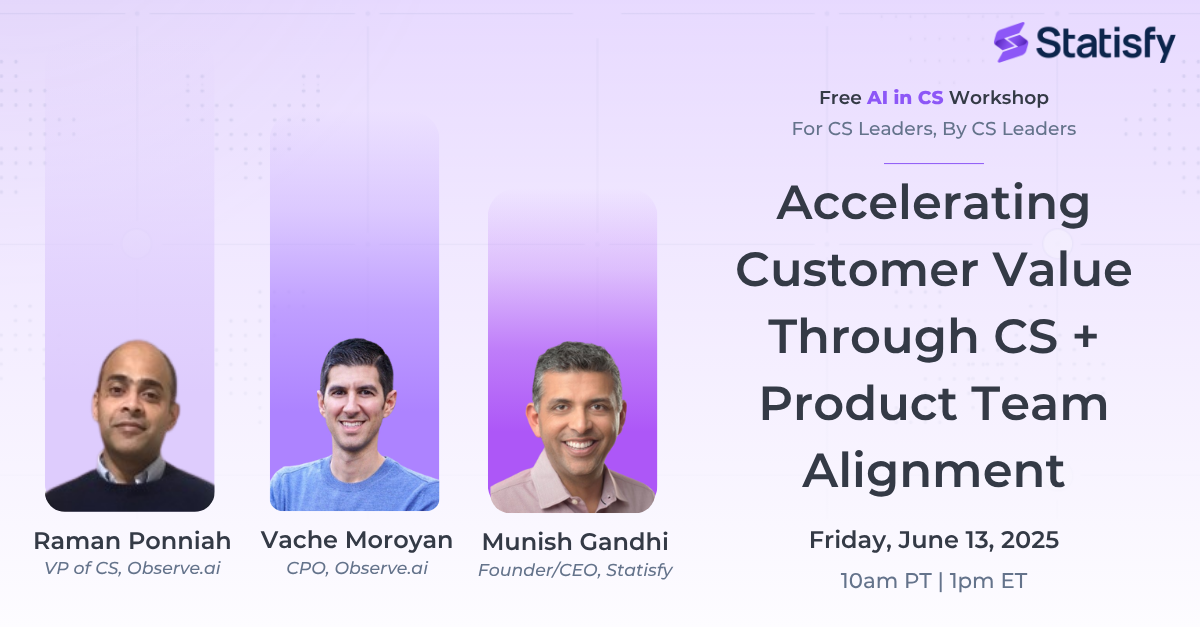
Check out our June 13th AI in CS Webinar notes
Here


Thank you to Vache and Raman for sharing your experiences and incredible insights!

Check out
Statisfy's AI-generated Session Summary:

Introduction and Objectives
Munish Gandhi, CEO of Statisfy, introduced Raman, VP of Customer Success at Observe.AI, and Vache, CPO at Observe.AI. The discussion focused on how Statisfy helps align customer success and product teams for better customer value delivery. Munish outlined Statisfy's goals: reducing CSM data entry, preventing last-minute customer surprises, and democratizing customer feedback across the organization.
Alignment Between Product and CS Teams
Raman emphasized that a customer-focused attitude across all departments, driven by leadership, is crucial for alignment. Both product and customer success teams are aligned on success metrics, such as delivering value and impacting customer metrics. Vache added that friction can arise when balancing individual customer needs with broader innovation, necessitating clear communication and customer engagement by the product team.
Tactical Approaches to Alignment
Raman and Vache communicate frequently, often engaging in customer-level strategy conversations. This helps the product team understand the reasons behind customer needs and identify common requirements across multiple customers. They also address the push and pull between existing and new customer needs, prioritizing based on strategic importance.
AI in Customer Feedback and Operations
The discussion shifted to how Observe.AI uses AI for operational impact. Before AI, customer feedback was gathered through QBRs and feedback tools, but this was inefficient and lacked clustering. Statisfy's AI proactively routes customer feedback, categorizes it, and pushes it to the product team, enabling quicker intervention. Additionally, AI automates pre- and post-meeting tasks, such as follow-up emails and task creation, improving efficiency for the customer success team.
Strategic Impact of AI and Customer Health
Customer health is measured across solution, value, and relationship dimensions. AI helps identify areas where customer health is lacking, enabling targeted action. Munish highlighted the importance of maintaining all three pillars—solution, outcomes, and relationships—for strategic customer engagement, especially in multi-year contracts where priorities and personnel may change.
Product Roadmap and AI
Vache discussed how AI assists in product roadmap management by aggregating product requests, organizing them into feature buckets, and providing data on requesting customers, their ARR, and renewal dates. This helps prioritize roadmap items based on business impact and customer sentiment. AI enhances the ability to understand who is asking for what, capture pain points, and cluster similar requests.
AI vs. Humans
Raman noted that AI excels at capturing data at scale, enabling faster action. Vache added that AI provides consistency, while humans excel at relationship building. The consensus was that AI should arm people with information to make informed decisions, rather than replace the human element entirely. Munish suggested that a better term than "human in the loop" might be "harmonization," emphasizing the division of labor between AI and humans.
Check out
Statisfy's AI-generated Session Summary:
